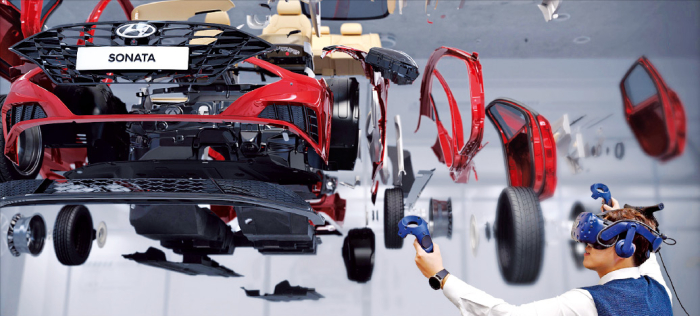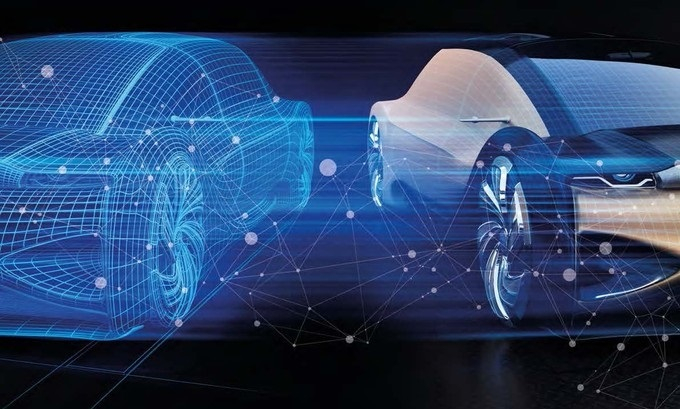Hyundai Motor to adopt digital twin in latest move of virtual technology use
Digital twin technology set to be introduced at HMGICS, allowing the automaker to create a digital replica of a real car for simulation not only in virtual space but also in the physical world
By Jul 05, 2021 (Gmt+09:00)
LG Chem to sell water filter business to Glenwood PE for $692 million


Kyobo Life poised to buy Japan’s SBI Group-owned savings bank


KT&G eyes overseas M&A after rejecting activist fund's offer


StockX in merger talks with Naver’s online reseller Kream


Mirae Asset to be named Korea Post’s core real estate fund operator



Hyundai Motor Group plans to adopt digital twin technology, which allows the automaker to make a digital replica of a real car for simulation not only in a virtual space but also in the physical world with related equipment.
Hyundai Motor Co. will introduce the technology to the design sector of Hyundai Mobility Global Innovation Center in Singapore (HMGICS), according to the information technology (IT) industry on July 5. HMGICS is an open mobility innovation base that Hyundai Motor is building by combining cutting-edge technologies such as artificial intelligence (AI), Internet of Things (IoT) and robotics. It will serve as a test bed for the entire automotive value chain, including Hyundai Motor's pilot production system for electric vehicles (EVs).
Hyundai, which has already used digital twin for some car designs, was set to expand the technology to the development of all models.
“Digital twin allows us to quickly reflect the power flow, resistance, and inter-part linkage without actual automotive prototypes," said Hyundai Motor Vice President Park Dong-il. "It takes time to build a system as we need massive data, but once we have a digital twin, we can dramatically advance the production process."
LOGISTICS, MANUFACTURING, ENERGY SECTORS MULL DIGITAL TWIN
Various industries such as manufacturing, logistics, and energy are also rushing to adopt digital twin since a relatively small investment linking the virtual space and reality can greatly increase productivity. For example, CJ Logistics Co. is considering the technology to streamline cargo flow and handle more freight at the same price by analyzing various factors.
Hyundai Heavy Industries Co. and HMM Co. are also developing digital twin ship platforms, respectively. By 2023, Hyundai Heavy aims to create a virtual reality of the physical environment for ship operations to check the performance of core facilities of liquefied natural gas (LNG) carriers by connecting some current facilities. GS Caltex is currently establishing a digital twin-based integrated control center that manages production facilities at its Yeosu refinery in South Jeolla Province by 2030.
LG Electronics Inc., introduced a production automation system based on digital twin to a washing machine factory in Tennessee, US, while LG Display Co. adopted such a system to an organic light emitting diode (OLED) display module plant in Vietnam. Both have already automated their production processes. The next step is to integrate control and efficiency, which is not easy. If an error occurs even at a single point after hastily improving the process, it could cause a huge blow to the whole production. AI is not an easy option either, given the risk of errors during the learning phase.
Digital twin does not have such issues. Companies can check all kinds of variables in virtual space, find the best way, and apply them immediately to reality. Digital twin learns in seconds to minutes what would take AI hundreds of hours, needing to learn from each phase when the equipment is working. Given these factors, electronics makers, which need to go through hundreds of processes to make a final product, are paying close attention to the technology.
The Korea Aerospace Industries (KAI) used digital twin to develop the KF-21 next-generation fighter jet, which unveiled its first prototype in April. The KAI prepared various parts and devices in both the virtual and physical space to connect design, engineering, and manufacturing processes to one platform. German industrial giant Siemens is another case. It connects actual aircraft propellers with virtual models and reflects changes in movement depending on wind speed and other factors. When the digital twin calculates a more stable propeller angle, it uses a two-way process that reflects it in the actual model.
DIGITAL TWIN COUNTRIES, CITIES
Some countries and cities are keen to implement digital twin technology as they can prepare for major natural disasters and diseases that cannot be tested in reality. South Korea’s government late last year announced that it will invest 1.2 trillion won ($1.1 billion) to build Digital Twin Land by 2025. Last month, Incheon City started producing an urban digital twin with Naver Labs.
The Ministry of Land, Infrastructure and Transport plans to select about five regions this month through a public contest for digital twin pilot projects for local governments.
“Many wanted to use digital twin to solve issues like water pollution or odor problems and preemptively manage energy, according to a preliminary demand survey,” said a ministry official.
The technology will help local authorities check the impact on water quality of a new plant before granting permission, for example. The technologies will help reflect the flow of water and air in the simulation, enabling local governments to factor more information into their decisions.

GOOD FOR ESG
Digital twin can reduce carbon emissions and waste, enhancing companies’ environmental, social, and governance (ESG) management. For example, a carmaker will be able to significantly reduce the number of prototype cars to develop a new model from dozens to hundreds with digital twin.
Sanofi, a global pharmaceutical maker, applied the technology to its plant in Framingham, US, cutting annual energy consumption and carbon emissions by about 80%. Chemical consumption dropped 94% by reflecting simulations to safely recycle solvents and burn less solvent waste.
Accenture, a global consulting firm, predicted carbon emissions will decrease by 7.5 gigatons by 2030, 23.8% of the world’s total carbon emissions last year, if the construction, electric/electronics, consumer goods, transportation and life sciences sectors adopt digital twin technology.
Write to Han-Gyeol Seon, Hyung-Kyu Kim and Min-Jun Suh at always@hankyung.com
Jongwoo Cheon edited this article.


